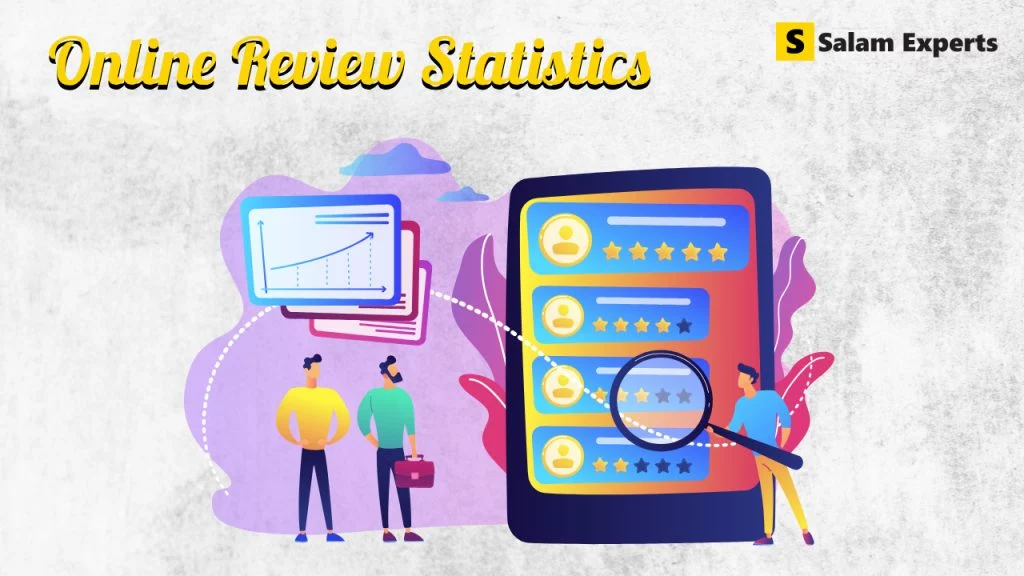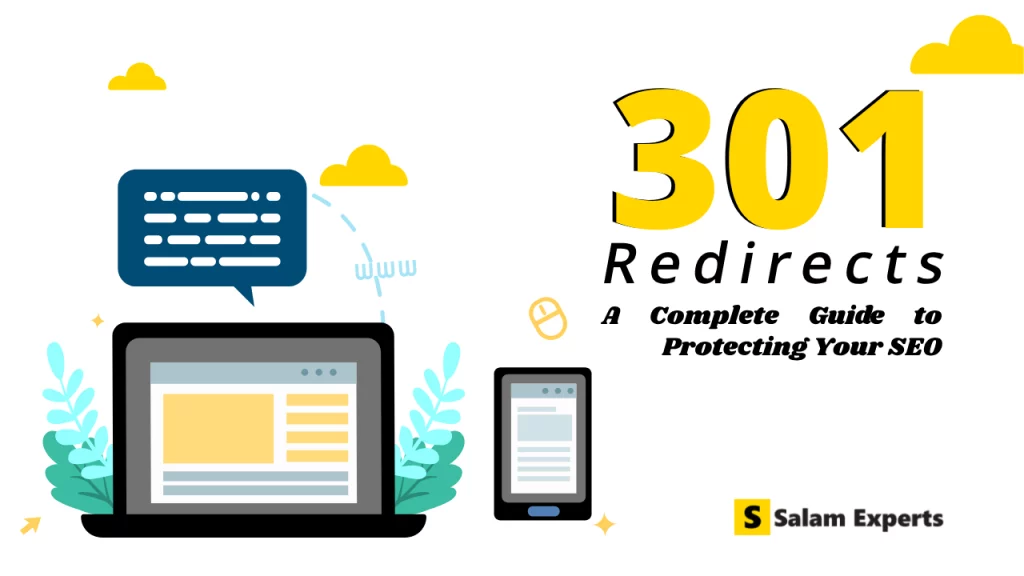Google Search Console Issues: Every Problem You Need to Know

Google Search Console is like a health monitor for your website’s search performance. Just as a doctor uses various tests to diagnose health issues, Search Console provides insights into problems that could be affecting your site’s visibility in Google search results.
This comprehensive guide covers every major issue you might encounter in Google Search Console, helping both SEO professionals and website owners understand, diagnose, and fix these problems effectively.
Understanding Google Search Console Issue Categories
Google Search Console organizes issues into several main categories:
- Page Indexing Issues – Problems preventing pages from being indexed
- Coverage Issues – Pages that can’t be crawled or indexed properly
- Core Web Vitals Issues – Page experience and loading performance problems
- Security Issues – Malware, hacking, or dangerous content warnings
- Manual Actions – Penalties applied by Google’s human reviewers
- Structured Data Issues – Problems with schema markup implementation
Let’s dive deep into each category.
Page Indexing Issues (Most Common)
These appear in the “Pages” report under “Why pages aren’t indexed.”
1. Crawled – Currently Not Indexed
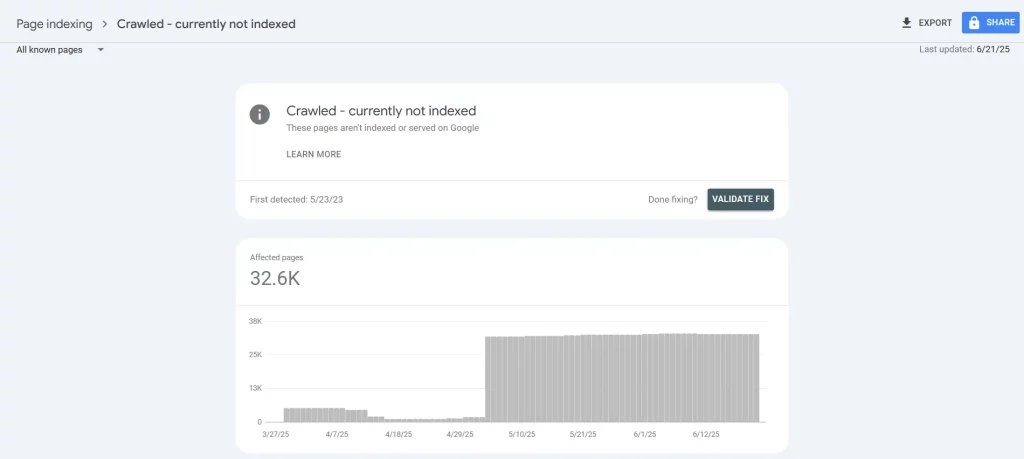
What it means: Google found and crawled your page but decided not to include it in search results.
Common causes:
- Low-quality or thin content
- Duplicate content issues
- Pages with little search value
- Technical quality issues
How to fix:
- Improve content quality and depth
- Add unique value to existing content
- Remove or consolidate duplicate pages
- Ensure pages serve a clear user intent
- Check for hidden duplicate content issues
2. Discovered – Currently Not Indexed
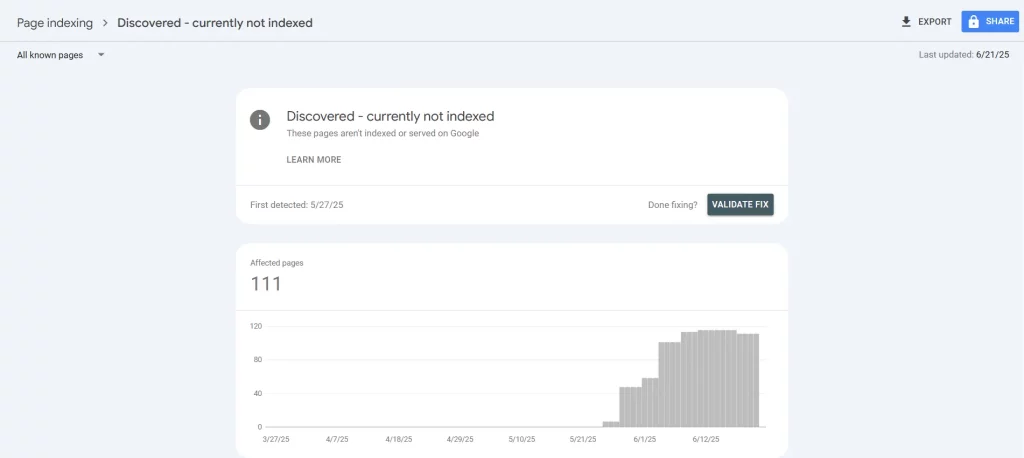
What it means: Google found your page (through links or sitemaps) but hasn’t crawled it yet.
Common causes:
- Low page authority or importance
- Crawl budget limitations
- Server response issues during discovery
- Pages buried deep in site architecture
How to fix:
- Improve internal linking to these pages
- Request indexing through URL Inspection tool
- Increase page importance through better content
- Fix any server response issues
- Move important pages higher in site hierarchy
3. Page with Redirect
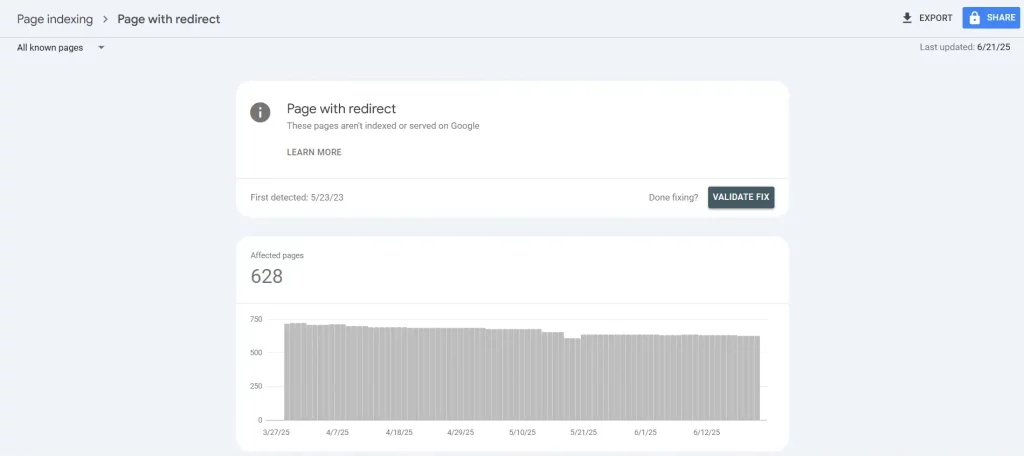
What it means: The page redirects to another page instead of serving content.
Common causes:
- Necessary redirects (HTTP to HTTPS, www canonicalization)
- Redirect chains or loops
- Old URLs still in Google’s index
- Plugin or CMS-generated redirects
How to fix:
- Remove unnecessary redirect chains
- Update internal links to skip redirects
- Clean XML sitemaps of redirecting URLs
- Fix redirect loops
- Use direct links instead of redirecting ones
4. Not Found (404)
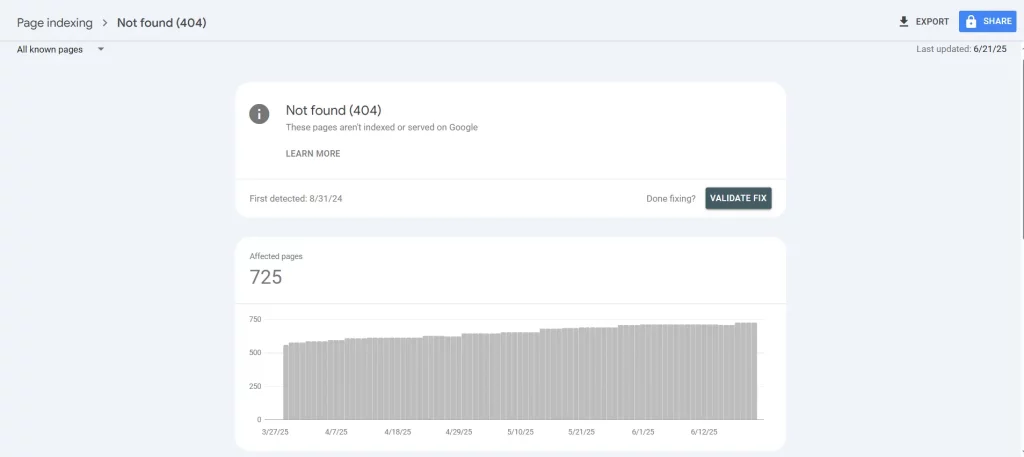
What it means: The page returns a 404 error when Google tries to access it.
Common causes:
- Pages that were deleted without redirects
- Broken internal or external links
- URL structure changes
- Server configuration issues
How to fix:
- Set up 301 redirects for important deleted pages
- Fix broken internal links
- Remove 404 pages from XML sitemaps
- Update or remove external links pointing to 404 pages
- Consider recreating important content that was accidentally deleted
5. Blocked by robots.txt
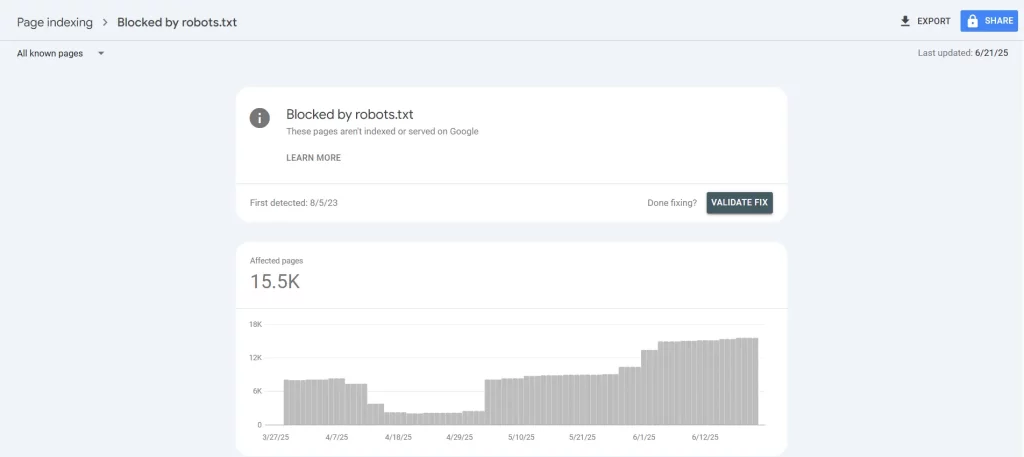
What it means: Your robots.txt file prevents Google from crawling these pages.
Common causes:
- Overly restrictive robots.txt rules
- Accidentally blocking important pages
- Blocking CSS/JS files (affects rendering)
- Plugin-generated robots.txt issues
How to fix:
- Review and update robots.txt file
- Test robots.txt using Search Console’s testing tool
- Ensure important pages aren’t blocked
- Allow Googlebot access to CSS and JavaScript files
- Check plugin settings that modify robots.txt
6. Excluded by Noindex Tag Applied
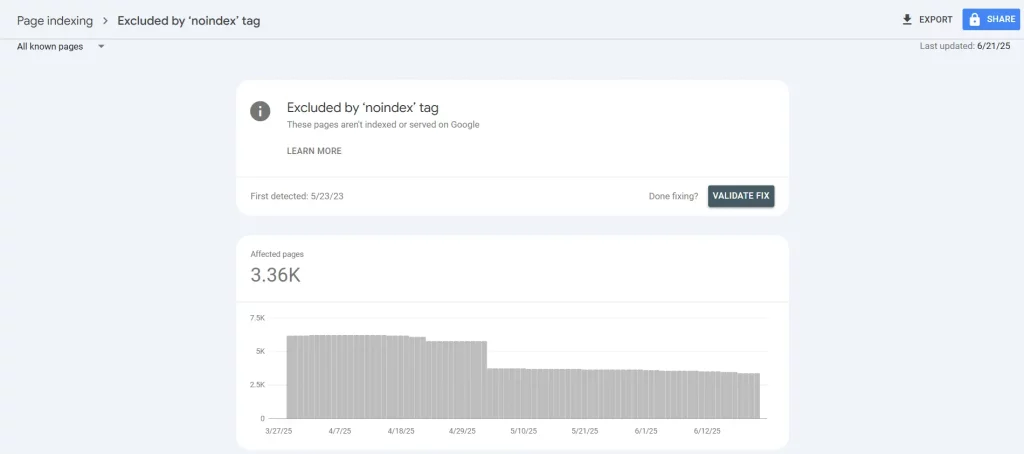
What it means: The page has a noindex meta tag or HTTP header preventing indexing.
Common causes:
- Intentional noindex on private pages
- Accidentally noindexing important pages
- Plugin settings adding noindex tags
- Staging site settings carried to live site
How to fix:
- Review pages with noindex tags
- Remove noindex from pages you want indexed
- Check SEO plugin settings
- Audit page templates for unwanted noindex tags
- Ensure staging site settings don’t affect live site
7. Blocked Due to Access Forbidden (403)
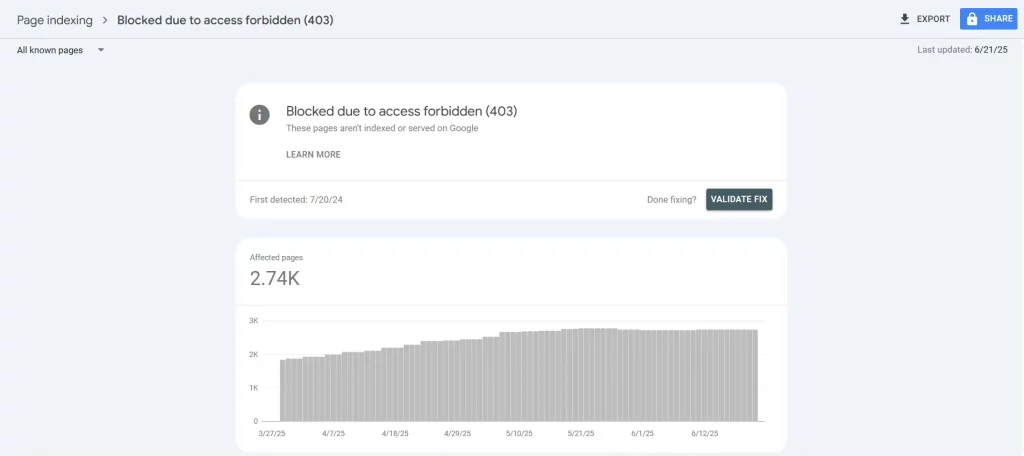
What it means: The server denies access to the page with a 403 error.
Common causes:
- Server permission issues
- Password-protected directories
- IP blocking or security restrictions
- File permission problems
How to fix:
- Check server file permissions
- Review security plugin settings
- Ensure Googlebot isn’t blocked by IP restrictions
- Fix htaccess permission issues
- Contact hosting provider for server-level problems
8. Server Error (5xx)
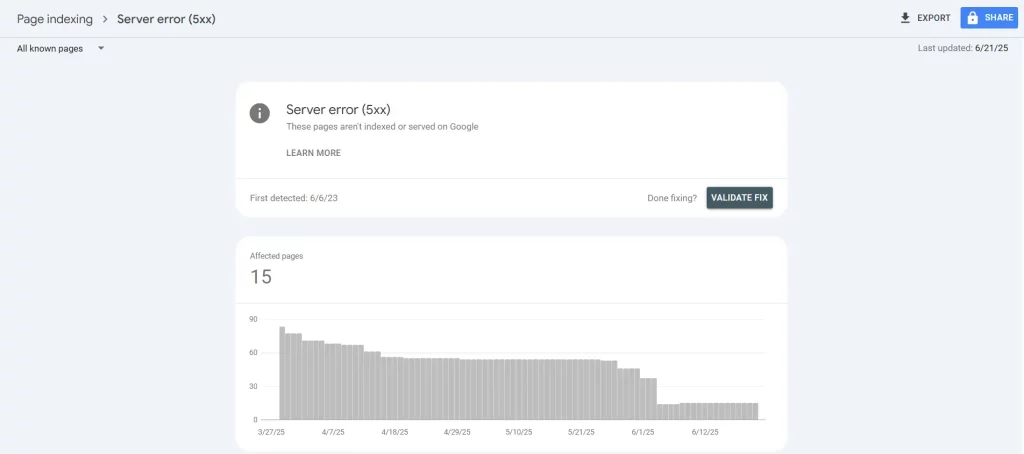
What it means: The server encountered an error when trying to serve the page.
Common causes:
- Server overload or downtime
- Database connection issues
- Plugin conflicts causing crashes
- Insufficient server resources
How to fix:
- Monitor server uptime and performance
- Identify and fix plugin conflicts
- Increase server resources if needed
- Optimize database queries
- Implement proper error handling
- Contact hosting provider for persistent issues
Core Web Vitals Issues
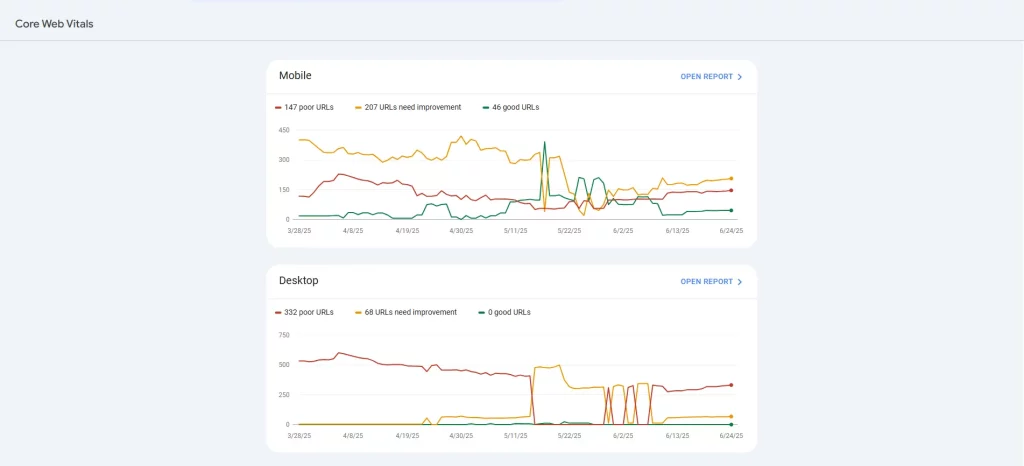
These measure page experience and loading performance.
1. Poor Loading Performance (LCP – Largest Contentful Paint)
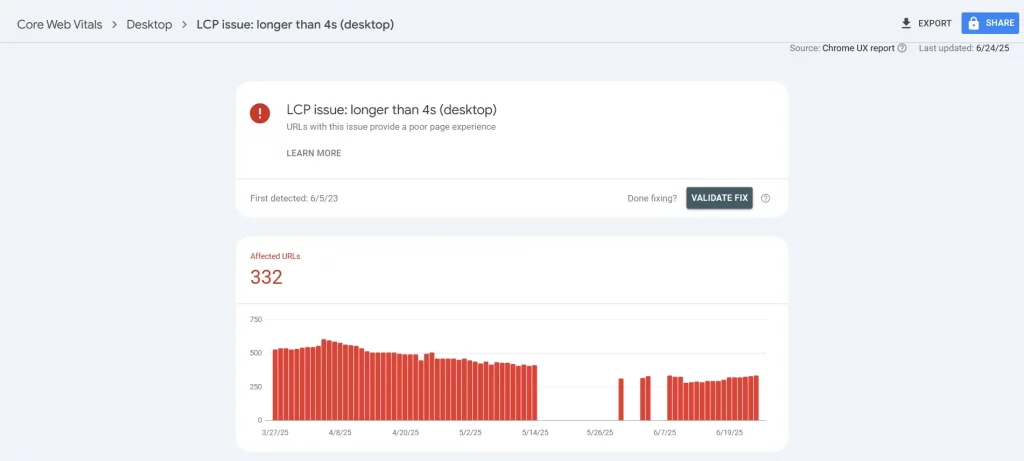
What it means: The largest content element takes too long to load (over 2.5 seconds).
Common causes:
- Large, unoptimized images
- Slow server response times
- Render-blocking resources
- Inefficient CSS and JavaScript
How to fix:
- Optimize and compress images
- Use modern image formats (WebP, AVIF)
- Implement lazy loading for images
- Minimize and defer CSS/JavaScript
- Improve server response times
- Use content delivery networks (CDNs)
2. Poor Interactivity (FID – First Input Delay)
What it means: The page takes too long to respond to user interactions (over 100ms).
Common causes:
- Heavy JavaScript execution
- Long-running scripts blocking main thread
- Large JavaScript bundles
- Third-party script issues
How to fix:
- Minimize and optimize JavaScript
- Use code splitting for large applications
- Defer non-critical JavaScript
- Optimize third-party scripts
- Use web workers for heavy computations
3. Poor Visual Stability (CLS – Cumulative Layout Shift)
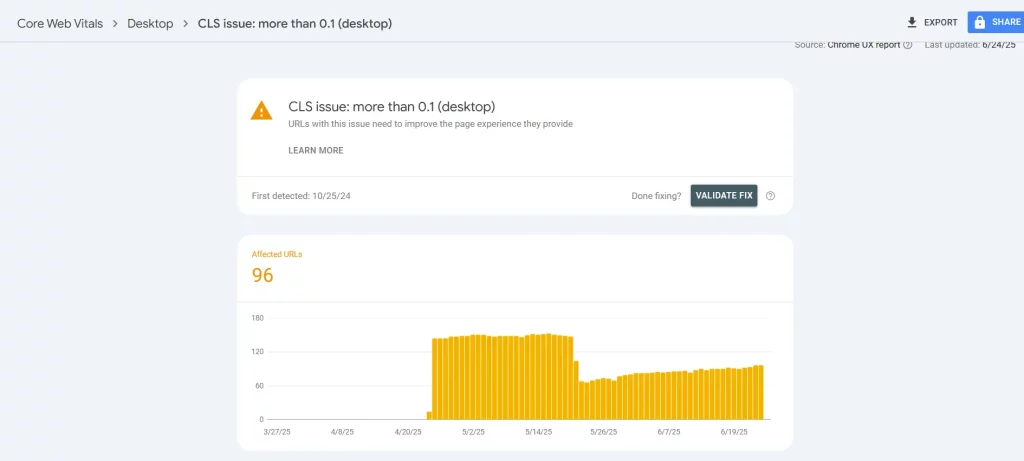
What it means: Page elements shift unexpectedly during loading (score over 0.1).
Common causes:
- Images without dimensions
- Ads or embeds loading dynamically
- Web fonts causing text reflow
- Dynamic content insertion
How to fix:
- Set explicit dimensions for images and videos
- Reserve space for ads and dynamic content
- Use font-display: swap for web fonts
- Avoid inserting content above existing content
- Preload critical fonts and images
Security Issues
These appear in the “Security Issues” report and require immediate attention.
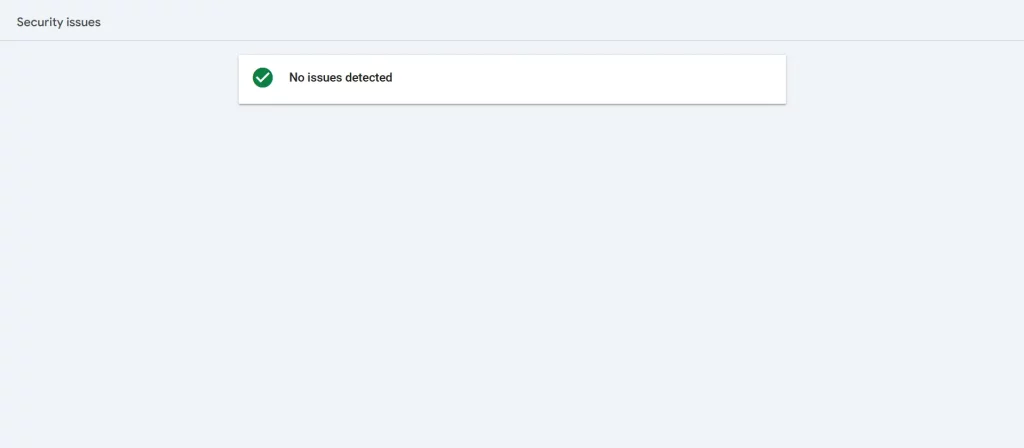
1. Malware Detection
What it means: Google detected malicious software on your website.
Immediate actions:
- Take the site offline if actively distributing malware
- Scan all files for malicious code
- Update all software, themes, and plugins
- Change all passwords
- Contact hosting provider
- Request a security review after cleaning
2. Deceptive Pages
What it means: Pages try to trick users into harmful actions (phishing, fake downloads).
How to fix:
- Remove all deceptive content
- Ensure all download links are legitimate
- Avoid misleading call-to-action buttons
- Be transparent about website purpose
- Request reconsideration after fixes
3. Harmful Downloads
What it means: Your site offers downloads that contain malware or unwanted software.
How to fix:
- Scan all downloadable files
- Remove infected files immediately
- Implement file scanning for uploads
- Only offer legitimate, safe downloads
- Submit for review after cleaning
Manual Actions (Penalties)
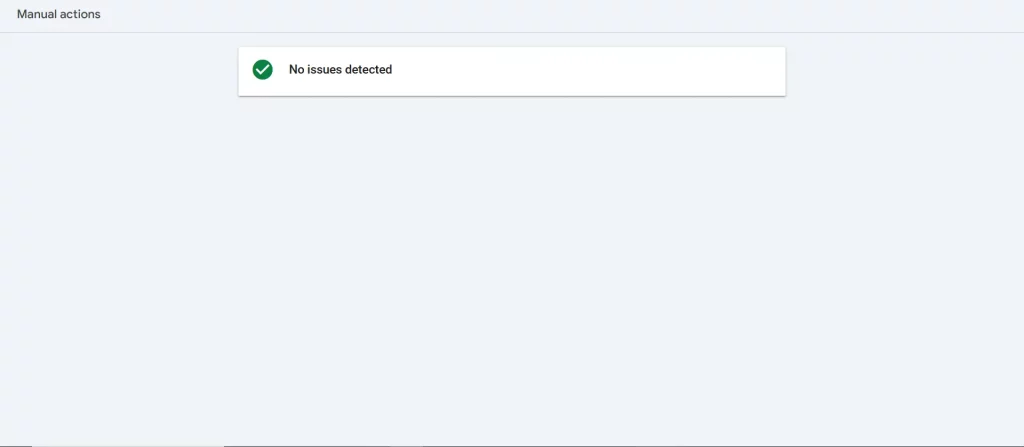
These are penalties applied by Google’s human reviewers.
1. Unnatural Links (Inbound)
What it means: Google detected artificial or low-quality backlinks pointing to your site.
How to fix:
- Audit your backlink profile using Search Console and third-party tools
- Contact sites to remove bad links
- Use Google’s Disavow Tool for links you can’t remove
- Focus on earning natural, high-quality links
- Submit a reconsideration request with documentation
2. Unnatural Links (Outbound)
What it means: Your site links to low-quality or spammy websites.
How to fix:
- Audit all outbound links on your website
- Remove or nofollow links to low-quality sites
- Avoid link schemes or paid link networks
- Only link to relevant, high-quality resources
- Update link policies and guidelines
3. Thin Content
What it means: Pages have little or no original content of value.
How to fix:
- Improve content quality and depth
- Add unique value and insights
- Remove or consolidate thin pages
- Focus on user intent and needs
- Create comprehensive, helpful content
4. Keyword Stuffing
What it means: Excessive use of keywords in an unnatural way.
How to fix:
- Rewrite content to sound natural
- Focus on topic coverage rather than keyword density
- Use synonyms and related terms
- Prioritize user experience over keyword optimization
- Follow Google’s content quality guidelines
5. Cloaking
What it means: Showing different content to search engines than to users.
How to fix:
- Ensure identical content for both users and crawlers
- Remove any cloaking scripts or techniques
- Use legitimate structured data markup
- Avoid hiding text or links from users
- Test pages using “Fetch as Google” tool
Structured Data Issues
Problems with schema markup implementation.
1. Missing Required Properties
What it means: Your structured data is missing essential fields.
How to fix:
- Review schema.org documentation for required properties
- Add missing required fields to your markup
- Use Google’s Rich Results Test tool
- Validate structured data before implementation
- Follow Google’s structured data guidelines
2. Invalid Property Values
What it means: Structured data contains incorrect or improperly formatted values.
How to fix:
- Check data types match schema requirements
- Ensure URLs are complete and valid
- Format dates and times correctly
- Use proper enumerated values where required
- Test all structured data implementations
3. Parsing Errors
What it means: Google can’t understand your structured data due to syntax errors.
How to fix:
- Validate JSON-LD syntax
- Check for missing commas, brackets, or quotes
- Ensure proper nesting of structured data
- Use structured data testing tools
- Consider using JSON-LD over Microdata
Advanced Issues and Solutions
Crawl Budget Optimization
For larger websites, crawl budget management becomes crucial:
Strategies:
- Prioritize important pages in XML sitemaps
- Use internal linking to guide crawler priority
- Fix crawl errors to avoid budget waste
- Block low-value pages in robots.txt
- Monitor crawl stats in Search Console
International SEO Issues
For multi-language or multi-region sites:
Common problems:
- Missing or incorrect hreflang tags
- Wrong language/region targeting
- Duplicate content across language versions
- Incorrect URL structure for international sites
Solutions:
- Implement proper hreflang annotations
- Use correct ISO codes for languages and regions
- Create unique content for each market
- Choose appropriate URL structure (subdirectories, subdomains, or ccTLDs)
E-commerce Specific Issues
Online stores face unique challenges:
Product page issues:
- Missing or incorrect structured data
- Duplicate product descriptions
- Out-of-stock page handling
- Faceted navigation creating duplicate content
Solutions:
- Implement proper product schema markup
- Create unique product descriptions
- Use proper handling for out-of-stock items
- Manage faceted navigation with canonical tags and robots.txt
Creating an Issue Resolution Workflow
1. Regular Monitoring Schedule
Weekly tasks:
- Check for new critical issues
- Monitor Core Web Vitals performance
- Review security alerts
Monthly tasks:
- Comprehensive crawl error analysis
- Mobile usability audit
- Structured data validation
Quarterly tasks:
- Complete technical SEO audit
- Backlink profile review
- Content quality assessment
2. Issue Prioritization Framework
Critical (Fix immediately):
- Security issues
- Manual actions
- Server errors affecting large portions of site
High Priority (Fix within 1 week):
- Core Web Vitals issues
- Mobile usability problems
- Important pages not indexed
Medium Priority (Fix within 1 month):
- Redirect chains
- Minor structured data issues
- Less important 404 errors
Low Priority (Fix when resources allow):
- Crawled but not indexed low-value pages
- Minor mobile usability issues
- Optional structured data enhancements
3. Documentation and Tracking
Maintain records of:
- Issue discovery dates
- Resolution actions taken
- Results and impact
- Lessons learned
- Prevention strategies implemented
Prevention Strategies
1. Proactive Monitoring
Set up alerts for:
- New critical issues in Search Console
- Significant drops in indexed pages
- Core Web Vitals threshold breaches
- Security issue notifications
2. Quality Assurance Processes
Before site changes:
- Test in staging environment
- Check impact on Search Console metrics
- Validate structured data
- Test mobile usability
- Monitor Core Web Vitals
3. Regular Maintenance
Monthly maintenance tasks:
- Update WordPress, themes, and plugins
- Review and update XML sitemaps
- Check for broken links
- Monitor site speed and performance
- Review security scans
Tools and Resources for Issue Resolution
Free Tools
Google Tools:
- Google Search Console (primary tool)
- PageSpeed Insights (Core Web Vitals)
- Mobile-Friendly Test
- Rich Results Test
- Lighthouse (Chrome DevTools)
Third-party Free Tools:
- Screaming Frog SEO Spider (limited free version)
- GTmetrix (site speed analysis)
- Pingdom (uptime monitoring)
- SSL Labs (SSL certificate testing)
Paid Tools
Comprehensive SEO Platforms:
- Ahrefs (technical SEO audit features)
- SEMrush (site audit tools)
- Moz Pro (crawl and optimization tools)
- DeepCrawl (enterprise-level crawling)
Specialized Tools:
- ContentKing (real-time SEO monitoring)
- Botify (enterprise crawl analysis)
- Sitebulb (visual site auditing)
- OnCrawl (log file analysis)
Working with Clients and Teams
Client Communication Strategies
When reporting issues:
- Prioritize issues by business impact
- Explain issues in non-technical terms
- Provide clear action plans with timelines
- Show potential traffic/revenue impact
- Document all changes and results
Setting expectations:
- Some fixes show immediate results, others take weeks
- Google’s processing time varies
- Prevention is more cost-effective than reactive fixes
- Regular monitoring prevents major issues
Team Collaboration
Developer collaboration:
- Provide specific technical requirements
- Use staging environments for testing
- Document all SEO-related code changes
- Establish SEO review processes for updates
Content team coordination:
- Create content guidelines based on Search Console insights
- Provide keyword and topic research from Search Console data
- Share performance data to guide content strategy
- Establish content quality standards
Measuring Success and ROI
Key Metrics to Track
Search Console metrics:
- Total indexed pages
- Click-through rates
- Average position improvements
- Core Web Vitals scores
- Mobile usability score
Business impact metrics:
- Organic traffic growth
- Conversion rate improvements
- Revenue from organic search
- Cost savings from issue prevention
Reporting Best Practices
Monthly reports should include:
- Issue resolution summary
- Performance improvements
- New issues discovered
- Preventive measures implemented
- Recommendations for next month
Future-Proofing Your SEO Strategy
Staying Updated with Google Changes
Regular monitoring:
- Google Search Central blog
- Search Console feature updates
- Algorithm update announcements
- Webmaster guidelines changes
Emerging Issues to Watch
Trends affecting Search Console:
- Core Web Vitals evolution
- Mobile-first indexing completion
- AI-generated content considerations
- Privacy and cookie changes impact
- Voice search optimization needs
Conclusion
Google Search Console issues might seem overwhelming, but with systematic approaches and regular monitoring, they become manageable. The key is understanding that these issues are opportunities to improve your website’s performance, user experience, and search visibility.
Success comes from:
- Regular monitoring to catch issues early
- Systematic prioritization based on business impact
- Proactive prevention through quality processes
- Continuous learning as Google’s requirements evolve
- Clear communication with clients and teams
Remember that Search Console is a diagnostic tool, not just an error reporter. Use its insights to build a stronger, more search-friendly website that serves both users and search engines effectively.
The investment in properly managing Search Console issues pays dividends through improved search performance, better user experience, and reduced emergency fixes. Start with the critical issues, build systematic processes, and gradually work toward a website that consistently performs well in Google’s search results.



